
Unlock a More Youthful You With Testosterone Replacement Therapy In New Village, NJ
Aging is inevitable, and for many, it signals the beginning of a new chapter - one where you cross off bucket list items and live life to the fullest, on your own terms. However, for some men, aging is a horrible prospect, filled with chronic fatigue, irritability, and inability to perform in the bedroom. If you're concerned about life in middle age and beyond, we've got great news: there are easy, proven steps that you can take to help stop the negative effect of aging.
Global Life Rejuvenation was founded to give men a new lease on life - one that includes less body fat, fewer mood swings, and more energy as you age. If you're ready to look and feel younger, it's time to consider TRT (testosterone replacement therapy), and growth hormone peptides. These therapies for men are effective, safe, and customized to fit your goals, so you can keep loving life as you get older.
TRT, and growth hormone peptide therapies bridge the gap between your old life and the more vibrant, happier version of you. With a simple click or call, you can be well on your way to a brighter future. After all, you deserve to be the one in charge of your wellness and health. Now, you have the tools to do so - backed by science and applied by our team of TRT and HRT experts with more than 13 years of experience.
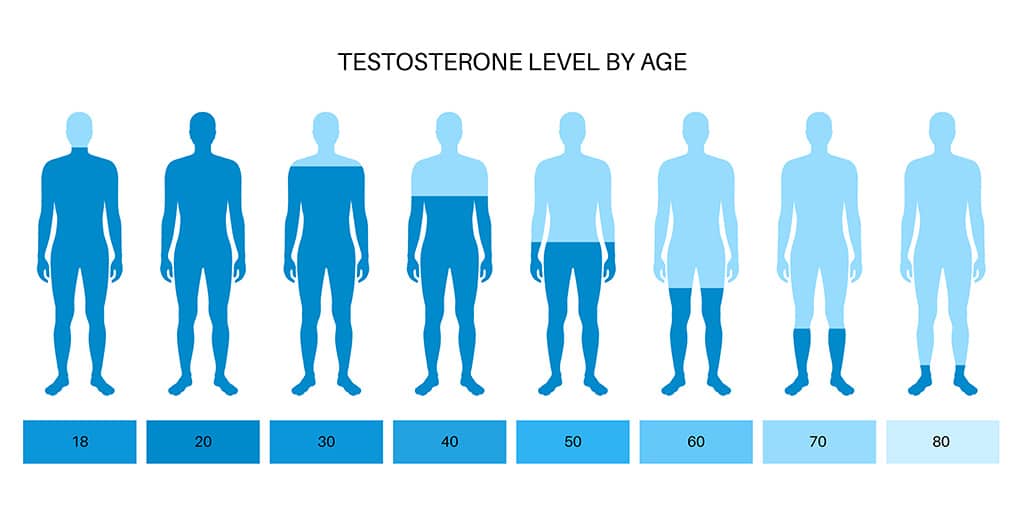
Testosterone Replacement Therapy
- Unlock A More Youthful You With Testosterone Replacement Therapy In New Village, NJ
- TRT and Anti-Aging Medicine for Men
- Common Symptoms of Low Testosterone
- Benefits of TRT and Anti-Aging Medicine for Men
- Fight Back Against Male Menopause
- Reverse Aging with Growth Hormone Peptides in New Village, NJ
- Your New, Youthful Lease on Life Starts Here
TRT and Anti-Aging Medicine for Men in New Village, NJ
For men, getting older comes with its perks, like living life on their own terms and not having to "sweat the small stuff" day in and day out. At the same time, there are aspects of aging that men dread, like hormonal changes. Yes, you read that right – men, not just women, go through hormonal changes as they age. For men, the biggest change involves a drop in testosterone.
Lower levels of testosterone can wreak havoc on a male's mind and body and when left untreated, can result in symptoms like:
- Erectile Dysfunction
- Depression
- Irritability
- Low Sex Drive
- Hair Loss
- Less Muscle Mass
- Problems Concentrating
Those symptoms are concerning, but with testosterone replacement therapy and anti-aging medicine, many males improve their quality of life with age. The good news is that TRT and anti-aging meds aren't only reserved for "old guys." In fact, there's no magic age at which men should start thinking about hormone replacement therapy. Everyone's body is different, so if you're experiencing the above conditions in your mid-30s, TRT could be a viable solution when you consult with a doctor.

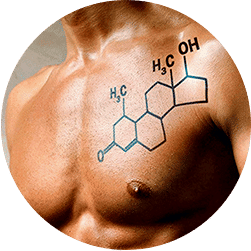
What is Testosterone?
Testosterone is a crucial hormone for men and plays an important role throughout the male lifespan. Most of a male's testosterone is produced through the testicles. Also called the male sex hormone, testosterone starts playing its part during puberty.
When a male goes through puberty, testosterone helps males develop:
- Facial Hair
- Body Hair
- Deeper Voice
- Muscle Strength
- Increased Libido
- Muscle Density
As boys turn to men and men grow older, testosterone levels deplete naturally. Sometimes, events like injuries and chronic health conditions like diabetes can lower testosterone levels. Unfortunately, when a man loses too much T, it results in hypogonadism. When this happens, the testosterone must be replaced, or the male will suffer from symptoms like muscle loss, low libido, and even depression.
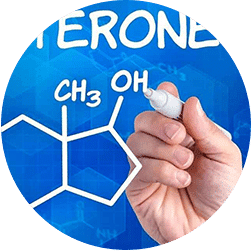
How Does TRT Work?
TRT is exactly what it sounds like: a treatment option for men that replaces testosterone so that your body regulates hormones properly and restores balance to your life. Also called androgen replacement therapy, TRT alleviates the symptoms that men experience with low T.
Originally lab-synthesized in 1935, testosterone has grown in popularity since it was produced. Today, TRT and other testosterone treatments are among the most popular prescriptions in the U.S.
Without getting too deep into the science, TRT works by giving your body the essential testosterone it needs to function correctly. As the primary androgen for both males and females, testosterone impacts many of the body's natural processes – especially those needed for overall health. For example, men with low T are more prone to serious problems like cardiovascular disease and even type-2 diabetes.
When your body quits making enough testosterone, it causes your health to suffer until a solution is presented. That's where TRT and anti-aging medicine for men can help. TRT helps balance your hormones and replenish your depleted testosterone. With time, your body will begin to heal, and many symptoms like low libido and irritability begin to diminish.

What Causes Low T?
For men, aging is the biggest contributor to lower testosterone levels, though there are other causes like obesity, drug abuse, testicular injuries, and certain prescribed medications. Sometimes, long-term health conditions like AIDS, cirrhosis of the liver, and kidney disease can lower testosterone levels.
When a man's testosterone levels drop significantly, it alters his body's ratio of estrogen and testosterone. Lower testosterone levels cause more abdominal fat, which in turn results in increased aromatase, which converts even more testosterone into estrogen.
If you're concerned that you might have low T, you're not alone. Millions of men in the U.S. feel the same way. The best way to find out if your testosterone is low is to get your levels tested.
For sustainable testosterone replacement therapy benefits, you must consult with hormone doctors and experts like those you can find at Global Life Rejuvenation. That way, you can find the root cause of your hormone problems, and our team can craft a personalized HRT plan tailored to your needs.
Common Symptoms of Low Testosterone
Are you used to blasting through a productive day and accomplishing all your daily goals? Do you find yourself losing muscle mass and the craving to be intimate with your partner? Does your partner complain about how irritable you have become? If you're not usually a curmudgeon, your body could be giving you a sign. It could be time to speak with a doctor about TRT and anti-aging medicine for men in New Village, NJ.
If you're experiencing any of the following symptoms, you might be battling against low testosterone:

Low Sex Drive
One of the most common reasons that men choose TRT is because they have lost that "spark" with their partner. It's not easy for a man to hear that they're not performing like they used to. Intimacy is a powerful part of any relationship. When a once-healthy sex life dwindles, it can cause serious relationship issues.
The good news is that low libido doesn't have to be a permanent problem. TRT and anti-aging medicines help revert hormone levels back into their normal range. When this happens, many men have a more enjoyable life full of intimacy and sex drive.

Inability to Achieve and Maintain an Erection
Weak erections – it's an uncomfortable subject for many men in the U.S. to talk about. It's even worse to experience first-hand. You're in the midst of an intimate moment, and you can't do your part. Despite being perfectly normal, many men put blame and shame upon themselves when they can't achieve an erection. And while the inability to perform sexually can be caused by poor diet, obesity, and chronic health conditions, low testosterone is often a contributing factor.
Fortunately, weak erections are a treatable condition. The best way to regain your confidence and ability in bed is to speak with your doctor. Once any underlying conditions are discovered, options like TRT may be the best course of treatment.
Hair Loss

Loss of Strength and Muscle Mass
Do you find it harder and harder to work out and lift weights in the gym? Are you having problems lifting heavy items that you once had no problem lifting?
Recent studies show that when men are inactive, they lose .5% of muscle strength every year, from ages 25 to 60. After 60, muscle loss doubles every decade. While some muscle loss is common as men age, a significant portion can be tied to low testosterone levels. When a man's T levels drop, so does his muscle mass.
Testosterone is a much-needed component used in gaining and retaining muscle mass. That's why many doctors prescribe TRT New Village, NJ, for men having problems with strength. One recent study found that men who increased their testosterone levels using TRT gained as much as 2.5 pounds of muscle mass.
Whether your gym performance is lacking, or you can't lift heavy items like you used to, don't blame it all on age. You could be suffering from hypogonadism.

Hair Loss
If you're like millions of other men in their late 20s and 30s, dealing with hair loss is a reality you don't want to face. Closely related to testosterone decline and hormone imbalances, hair loss is distressing for many men. This common symptom is often related to a derivative of testosterone called DHT. Excess amounts of DHT cause hair follicles to halt their production, causing follicles to die.
Because hair located at the front and crown is more sensitive to DHT, it grows slower than other follicles and eventually stops growing permanently. Thankfully, TRT and anti-aging treatments for men in New Village, NJ, is now available to address hair loss for good.
While it's true that you can't change your genes, you can change the effects of low testosterone on your body. Whether you're suffering from thinning hair or hair loss across your entire head, TRT and other hormone therapies can stop hair loss and even reverse the process.
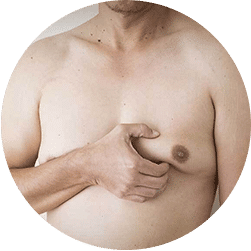
Gynecomastia
Also called "man boobs," gynecomastia is essentially the enlargement of male breast tissue. This increase in fatty tissue is often caused by hormonal imbalances and an increase in estrogen. For men, estrogen levels are elevated during andropause. Also called male menopause, andropause usually happens because of a lack of testosterone.
If you're a man between the ages of 40 and 55, and you're embarrassed by having large breasts, don't lose hope. TRT is a safe, effective way to eliminate the underlying cause of gynecomastia without invasive surgery. With a custom HRT and fitness program, you can bring your testosterone and estrogen levels back to normal before you know it.

Decreased Energy
Decreased energy was once considered a normal part of aging. Today, many doctors know better. Advances in technology and our understanding of testosterone show that low T and lack of energy often go hand-in-hand.
If you're struggling to enjoy activities like playing with your kids or hiking in a park due to lack of energy, it could be a sign of low T. Of course, getting tired is perfectly normal for any man. But if you're suffering from continual fatigue, a lack of enjoyment, or a decrease in energy, it might be time to speak with a doctor.
Whether you're having a tough time getting through your day or can't finish activities you used to love, TRT could help.
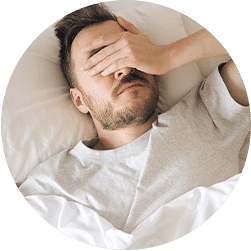
Lack of Sleep
A study from 2011 showed that men who lose a week's worth of sleep can experience lowered testosterone levels – as much as 15%, according to experts. Additional research into the topic found almost 15% of workers only get five hours of sleep (or less) per night. These findings suggest that sleep loss negatively impacts T levels and wellbeing.
The bottom line is that men who have trouble sleeping often suffer from lower testosterone levels as a result. If you find yourself exhausted at the end of the day but toss and turn all night long, you might have low T.
TRT and anti-aging medicines can restore your T levels back to normal, which can help you sleep better with proper diet and exercise.

Depression
You're feeling down about everything, and there's no solid explanation for why you're in such a crummy mood. Your daily life is great and full of success, but you can't help but feel unexcited and unmotivated. If you're experiencing symptoms like these, you may be depressed – and it may stem from low testosterone.
A research study from Munich found that men with depression also commonly had low testosterone levels. This same study also found that depressed men had cortisol levels that were 67% higher than other men. Because higher cortisol levels lead to lower levels of testosterone, the chances of severe depression increase.
Depression is a very real disorder and should always be diagnosed and treated by your doctor. One treatment option gaining in popularity is TRT for depression. Studies show that when TRT is used to restore hormone levels, men enjoy a lighter, more improved mood. That's great news for men who are depressed and have not had success with other treatments like anti-depression medicines, which alter the brain's chemistry.
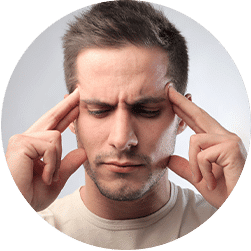
Inability to Concentrate
Ask anyone over the age of 50 how their memory is, and they'll tell you it wasn't what it used to be. Memory loss and lack of concentration occur naturally as we age – these aren't always signs of dementia or Alzheimer's.
However, what many men consider a symptom of age may be caused by low testosterone. A 2006 study found that males with low T levels performed poorly on cognitive skill tests. These results suggest that low testosterone may play a part in reducing cognitive ability. If you're having trouble staying on task or remembering what your schedule is for the day, it might not be due to your age. It might be because your testosterone levels are too low. If you're having trouble concentrating or remembering daily tasks, it could be time to talk to your doctor.
Why? The aforementioned study found that participating men experienced improved cognitive skills when using TRT.

Weight Gain
Even though today's society is more inclusive of large people, few adults enjoy gaining weight as they age. Despite their best efforts, many men just can't shed the extra pounds around their midsections, increasing their risk of heart disease and cancer.
Often, male weight gain is caused by hormone imbalances that slow the metabolism and cause weight to pile on. This phase of life is called andropause and happens when there is a lack of testosterone in the body. Couple that with high cortisol levels, and you've got a recipe for flabby guts and double chins.
Fortunately, TRT treatments and physician-led weight loss programs can correct hormone imbalances and lead to healthy weight loss for men.
Benefits of TRT and Anti-Aging Medicine for Men in New Village, NJ
The benefits of hormone replacement therapy for men are numerous. TRT not only grants relief from low-T symptoms but can help give protection against age-related diseases. Additionally, doctors now recognize male testosterone as an important role in alleviating depression.
Some of the most exciting benefits of TRT can include:
- Reduction in Body Fat
- Increased Strength
- More Muscle Mass
- More Energy
- Lower Risk of Erectile Dysfunction
- Higher Sperm Production
- Healthy Reproductive Tissues
- Lower Risk of Heart Disease and Diabetes
- Lower Risk of Anxiety
- Lower Risk of Depression


Fight Back Against Male Menopause
Because men do not go through a specific period of hormonal changes like women do (called menopause), many doctors refer to "male menopause" as androgen decline. This is just another term for low testosterone, but like female menopause, the symptoms can be serious and affect your quality of life.
The best way to fight back against male menopause is with male HRT treatment from Global Life Rejuvenation. We provide the following HRT treatments for men:
- Testosterone Replacement Therapy (TRT)
- Sermorelin (Sermorelin Acetate)
- Human Growth Hormone (HGH)
Our treatment options are personalized for your body and are available as creams, gels, injectables, and implantable pellets. To find out if testosterone replacement therapy is safe for you, contact Global Life Rejuvenation today to schedule your comprehensive testing and anti-aging treatment consultation.
Reverse Aging with Growth Hormone Peptides in New Village, NJ
Growth hormone peptides are an innovative therapy that boosts the natural human growth hormone production in a person's body. These exciting treatment options help slow down the aging process and give you a chance at restoring your youth.
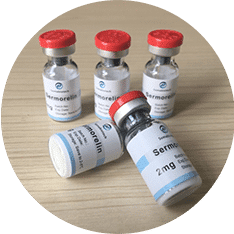
What is Sermorelin?
Sermorelin is a synthetic hormone peptide, like GHRH, which triggers the release of growth hormones. When used under the care of a qualified physician, Sermorelin can help you lose weight, increase your energy levels, and help you feel much younger.

Benefits of Sermorelin
Human growth hormone (HGH) therapy has been used for years to treat hormone deficiencies. Unlike HGH, which directly replaces declining human growth hormone levels, Sermorelin addresses the underlying cause of decreased HGH, stimulating the pituitary gland naturally. This approach keeps the mechanisms of growth hormone production active.
Benefits of Sermorelin include:
- Better Immune Function
- Improved Physical Performance
- More Growth Hormone Production
- Less Body Fat
- Build More Lean Muscle
- Better Sleep
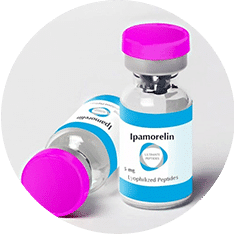
What is Ipamorelin?
Ipamorelin helps to release growth hormones in a person's body by mimicking a peptide called ghrelin. Ghrelin is one of three hormones which work together to regulate the growth hormone levels released by the pituitary gland. Because Ipamorelin stimulates the body to produce growth hormone, your body won't stop its natural growth hormone production, which occurs with synthetic HGH.
Ipamorelin causes growth hormone secretion that resembles natural release patterns rather than being constantly elevated from HGH. Because ipamorelin stimulates the natural production of growth hormone, our patients can use this treatment long-term with fewer health risks.

Benefits of Ipamorelin
One of the biggest benefits of Ipamorelin is that it is suitable for both men and women. It provides significant short and long-term benefits in age management therapies, boosting patients' overall health, wellbeing, and outlook on life. When growth hormone is produced by the pituitary gland using Ipamorelin, clients report amazing benefits.
Some of those benefits include:
- Powerful Anti-Aging Properties
- More Muscle Mass
- Less Unsightly Body Fat
- Deep, Restful Sleep
- Increased Athletic Performance
- More Energy
- Less Recovery Time for Training Sessions and Injuries
- Enhanced Overall Wellness and Health
- No Significant Increase in Cortisol
Your New, Youthful Lease on Life Starts Here
Whether you are considering our TRT services, HRT for women, or our growth hormone peptide services, we are here to help. The first step to turning back the hand of time starts by contacting Global Life Rejuvenation.
Our friendly, knowledgeable TRT and HRT experts can help answer your questions and walk you through our procedures. From there, we'll figure out which treatments are right for you. Before you know it, you'll be well on your way to looking and feeling better than you have in years!
 866-793-9933
866-793-9933
Request a Consultation
Latest News in New Village, NJ
How Transit Villages Are Reshaping New Jersey’s Urban Landscape
Marcelo Remondhttps://www.planetizen.com/blogs/125147-how-transit-villages-are-reshaping-new-jerseys-urban-landscape
The historic Central Railroad of New Jersey Terminal, Liberty State Park, Jersey City, New Jersey. | TTstudio / Central Railroad of New Jersey Terminal, Liberty State ParkAh, New Jersey, the state known for the Jersey Shore, pizza, and of course The Sopranos. The small state also happens to be the most ...
The historic Central Railroad of New Jersey Terminal, Liberty State Park, Jersey City, New Jersey. | TTstudio / Central Railroad of New Jersey Terminal, Liberty State Park
Ah, New Jersey, the state known for the Jersey Shore, pizza, and of course The Sopranos. The small state also happens to be the most densely populated in the country. Due to this, the Garden State has no shortage of thriving urban environments. Jersey City has been growing exponentially for the last several decades, and, along with Hoboken, has been nationally acclaimed for its great success in programs such as Vision Zero. But even though these cities are getting the spotlight, other towns in the state are making equally exciting progress in other topics.
Some background is necessary. Just like other older states, New Jersey possesses a traditional urban development pattern in several of its towns. One of the best examples of this traditional landscape is the famous streetcar suburb, a type of town that only came to exist due to train stations or streetcar lines nearby. The development followed transportation, creating dense communities around public transit. Yet like most of America in the mid-20th century, New Jersey started destroying its urban transit systems and ceding the landscape to the motor vehicle. Single-family homes and highways started to proliferate in the Garden State.
After decades of urban experimentation, a turning point occurred. It can be attributed in part to Jane Jacobs's masterpiece The Death and Life of Great American Cities, or maybe to the fact that authoritarian urban planning was just not popular; it does not really matter as they all had the same effect—a shifting urban design paradigm. Accordingly, a new movement began in the 1980s, known today as New Urbanism. The movement was founded on three main ideas: walkable blocks and streets, traditional neighborhood development (TND), and transit-oriented development (TOD).
This last item—paired with the fast development of issues such as climate change and the housing crisis (and their connection with the built environment)—spurred a call to action to solve our most concerning urban issues. Therefore, the urban landscape started being seen as something that could not be ignored and needed to change.
In 1990, New Jersey created an initiative called “The Transit Village,” with the main purpose of improving and revitalizing the surrounding areas of train stations. This would help the Garden State reduce gas carbon emissions by letting people live near the train station (and other amenities), and increase the number of housing units in downtowns across the state.
The initiative is simple enough. If a municipality gets the transit village designation, then the town is eligible for grants from the New Jersey Department of Transportation and can receive additional funding and technical assistance from state agencies. Additional resources, such as the Manual of Best Practices for Transit-Oriented Development, are always available and further help towns expand on their plans. Most of this does not come for free, however. According to the New Jersey Department of Transportation, towns can only be designated as Transit Villages if “These municipalities have demonstrated a commitment to revitalizing and redeveloping the area around their transit facilities into compact, mixed-use neighborhoods with a strong residential component.” Also, towns must comply with formal criteria and an application process.
This is not to promote bureaucracy or slow progress but to further ensure that the money and time spent are going to municipalities committed to improving their residents’ quality of life. In other words, the initiative is not for municipalities trying to get some extra capital for not-related projects, or who have not embraced New Urbanist thinking.
The program started with only five towns. Now, more than 30 towns are designated as Transit Villages, with Atlantic City being the latest addition, becoming the 35th member of the initiative. The program has achieved incredible progress on its mission of making areas near train stations more attractive. According to a special report from New Jersey Future by research director Tim Evans, “Transit station neighborhoods went from accounting for a meager 2.3 percent of total statewide population growth from 2000 to 2007 to accounting for a remarkable 38.3 percent of statewide growth from 2008 to 2012 ” (p.2). This means that in just over a decade, the urban growth in TODs has increased by nearly twentyfold. This shift towards transit-oriented lifestyles reflects the changing preferences of residents who are seeking the benefits of living in walkable, well-connected communities.
These changing preferences continue to trend in a positive direction. In an email exchange on August 7, 2023, Evans stated “There are 153 municipalities that host at least one transit station (rail, ferry, or major bus terminal). Those municipalities accounted for 70.8% of total statewide (NJ) population growth between 2010 and 2020, compared to only 27.8% of the state total between 2000 and 2010.” Even though this signals a broader trend (as this figure was at the municipal level and not specifically near transit stations), this shows the growing demand for walkable and transit-friendly spaces. Moreover, this data suggests the potential benefits that the Transit Village initiative could offer to numerous other towns across the state.
One New Jersey town that could rapidly benefit from these changes is Iselin. Iselin possesses the fourth busiest train station in the state, Metropark. With direct access to New York City through NJ Transit’s Northeast Corridor and Amtrak lines that go as far as Washington D.C., the station sees movement all day long. When Metropark was built, it was planned for suburbanites who would drive from their single-family homes to the train station. Thus, giant parking decks were constructed, occupying most of the space. But in 2022, the future seemed a little brighter. Under a new plan, this station would convert from a park-and-ride into a prospering transit-oriented development. The concept calls for 230 to 250 housing units and 250,000 square feet of office space with ground-level retail. This would completely transform the suburban nature of Iselin into a more diverse environment, creating a prosperous transit-oriented development where people can live, eat, work, and access transportation without a car. Towns like this can then could opt for a Transit Village designation, which could further build on the potential of the TOD. For instance, it could create a better connection to downtown, which at the moment is separated by the high-speed, four-lane Lincoln Highway and further complicated by a lack of sidewalks.
All of this new growth in transit-oriented villages also means a win for the fight against climate change. According to a series of articles from the Land Use Law Center at Pace University, “Transit-Oriented Development increases climate-resilient development by reducing greenhouse gasses and the amount of land necessary to accommodate a growing population and economy.” And it makes sense—when analyzing the population growth, it can be appreciated that despite the fact that the 153 municipalities represent less than half of the total New Jersey 565 municipalities/towns, they still managed to account for 70.8 percent of the total statewide population growth! It is clear that transit-friendly villages are synonymous with efficient land use.
The program has helped undo the terrible damage done to our downtowns in the past. Visibly significant undertakings, such as the transformation of parking lots into mixed-use developments, are just the surface of the Transit Village initiative’s achievements. Just take a look at another New Jersey town, Bloomfield. Less than two decades ago, most of the land near the century-old Bloomfield Station was parking lots. In 2023, the town redeveloped two parking lots near the train station into thriving mixed-use developments, and two more mixed-use developments are in the works. Now, thanks to the Transit Village Initiative, Bloomfield’s residents can easily live, shop, exercise, dine, and take the train within a radius of less than 0.2 miles.
Another great example can be found in Cranford, also a town with a historic train station. In 1997, Cranford Township was struggling to improve and rehabilitate its downtown. Despite a $3 million investment and a previous designation as a special improvement district, the magical moment had still not happened. The problem—as it was then shown in a commissioned report by Danth Inc.—was the suburban development pattern of Cranford’s downtown. Things needed to change. Accordingly, Cranford adopted the Transit-Friendly Village designation in 2003. Local officials knew that the train station needed to be the focus of the town. Since then, mix-used developments have been constructed in front of the station, with more planned for the future in other areas. The decision of challenging the status quo resulted in a vibrant downtown and thriving community.
It then can be said that thanks to the Transit Village initiative, more New Jerseyans have a chance to experience urban life. People in Bloomfield and Cranford are better off now than they were 15 to 20 years ago, and are enjoying the benefits of TOD. The program showed that demand for density was always there, it just needed the right vision and planning to flourish. At the same time, the initiative serves as a vital tool in the fight against climate change and the housing shortage by creating more efficient land use patterns. This success story serves as an example for other states who face similar issues and signals that the policies of the past, however ingrained, are not permanent. Most importantly, it shows that change is possible—and that it is already happening.
Land Use Transportation Urban Development New Jersey Transit Village View More
6 Abandoned and Forgotten Ghost Towns in New Jersey
Nixza Gonzalezhttps://a-z-animals.com/blog/abandoned-and-forgotten-ghost-towns-in-new-jersey/
Ghost towns aren’t just limited to the wild west. They are also common in northern states, like New Jersey. Many New Jersey ghost towns, though, are difficult to find. Only a few buildings, if any, remain in many of these deserted and forgotten spots.Follow along to discover 6 abandoned and forgotten ghost towns in New Jersey.Batsto VillageStarting our list of ghos...
Ghost towns aren’t just limited to the wild west. They are also common in northern states, like New Jersey. Many New Jersey ghost towns, though, are difficult to find. Only a few buildings, if any, remain in many of these deserted and forgotten spots.
Follow along to discover 6 abandoned and forgotten ghost towns in New Jersey.
Batsto Village
Starting our list of ghost towns in New Jersey is the Batsto Village. It’s one of the easiest ghost towns to visit in the state. This deserted town is certainly not forgotten. It’s a historical unincorporated community with many remaining old and fascinating buildings. Basto Village first began to grow in 1766, when Charles Read built the Batsto Iron Works along the Batsto River. This Iron Works successfully produced household items like pots and pans. The ghost town truly expanded in the 1800s when families moved to find work. When the iron industry declined, Batsto Village relied on glass-making.
Now, you can visit this historical site, which is listed on the National Register of Historic Places. Guided tours are available, which include the Batsto Mansion and the Atsion Mansion. The visitor center hosts an informational museum and a beautiful exhibit gallery. Events are also held in the Batsto Village, like the Country Living Fair.
Ong’s Hat
Not much remains of Ong’s Hat (or Ong’s Hut, depending on which legend you believe). Although a ghost town, it’s not forgotten! Ong’s Hat has a long history. Although historians aren’t sure when the village got its name, it’s older than the revolutionary war. This name appears in a 1778 map of Hessian encampments in New Jersey. The town’s peak may have been in the 1860s. However, by the 1930s, while the town’s name remained on maps, there was nothing there but a few brick remains, an open clearing, and an abandoned shed. Some historians aren’t sure if Ong’s Hat was ever a real village. Today, it is a terminus of the Batonia Trail, one of the longest in the state.
If you think Ong’s Hat is strange, you aren’t the only one. According to a conspiracy theory-based story dating back to the 1980s, a group of scientists travels to a creepy parallel universe from Ong’s Hat. One of the core writers/storytellers wrote a book titled, The Incunabula Papers: Ong’s Hat And Other Gateways To New Dimensions. Although he stated that this work was pure fiction, some people believe that Ong’s Hat is part of a bigger conspiracy.
Feltville
Next on our list of ghost towns in New Jersey is Feltville. Like Batsto Village, Feltville is relatively well-known. Many buildings remain in this abandoned ghost town. Although almost completely abandoned except for three families, Fetlville is now Feltville Historic District. Another name for this village/site is the Deserted Village.
Although the town/village was built in 1825, the first European settler moved to the area in 1736. Peter Willcox, the first settler, built a sawmill, but its days were limited. It was demolished as the population of the area grew. A century after Peter Willcox moved to the area, David Felt purchased land from Willcox’s ancestors and built a mill on Blue Brook, two dams, and a village for workers. Although successful under David Felt, he sold the land to different businesses, that eventually left the area and the buildings abandoned. One of these businesses was a summer resort.
Allaire Village
Another New Jersey ghost town is Allaire Village. Although a ghost town, it’s also a living history museum. You can find this interactive museum in Allaire State Park. Long before European settlers came to the area, the land under the village was an Indian ceremonial ground.
The village was built in 1750. One of the first settlers was Issac Palmer. However, the village is named after James P. Allaire, who purchased the land in 1822. At the village’s peak, it was home to about 500 people. However, the village’s success declined drastically after the wood-burning furnace business collapsed. Although mostly left abandoned after the late 1800s, some buildings were used by passing residents. The village was also used as a backdrop for a few silent movies.
Waterloo Village
Waterloo Village is a historic site in Stanhope, New Jersey. This village is called the Waterloo Village Historic Site. It’s open to the public, with tours available Saturdays and Sundays between June and September. Not only can you visit this historic site to learn more about the village and its buildings, but also hike surrounding nature trails.
Waterloo Village was built in 1820. Its location about halfway along the Morris Canal made it a convenient stopover and service center. This 19th-century ghost town is located on about 70 acres of land. This open-air museum is on the National Register of Historic Places. Buildings that remain standing include Smith’s General Store, the Blacksmith Shop, Peter D. Smith House, Smith Homestead House, and the United Methodist Church.
Walpack Center
Last but not least is the Walpack Center. It’s an unincorporated community in the much larger Walpack Township. This ghost town was previously a farming community built in the 1800s. Although not completely abandoned, it declined tremendously during the 1900s as larger cities grew around this community. You can visit the Walpack Center Historic District to see old buildings like a small schoolhouse built in 1856.
Summary of 6 Abandoned and Forgotten Ghost Towns in New Jersey
The photo featured at the top of this post is © Wangkun Jia/Shutterstock.com
Final Plans for a New Ablett Village Going to Camden Planning Board
NEILL BOROWSKIhttps://www.tapinto.net/towns/camden/sections/development/articles/final-plans-for-a-new-ablett-village-going-to-camden-planning-board
CAMDEN, NJ – When a project to demolish and replace the 81-year-old Ablett Village goes before the Camden Planning Board on August 31, it will be the largest piece of an overall $150-million project that is transforming public housing in the Cramer Hill section.The Michaels Organization, the Camden-based developer leading the project, will present the board with proposals for final site plans for both phases of the Ablett Village project.That project calls for constructing 12 new buildings containing 78 new townhomes in t...
CAMDEN, NJ – When a project to demolish and replace the 81-year-old Ablett Village goes before the Camden Planning Board on August 31, it will be the largest piece of an overall $150-million project that is transforming public housing in the Cramer Hill section.
The Michaels Organization, the Camden-based developer leading the project, will present the board with proposals for final site plans for both phases of the Ablett Village project.
That project calls for constructing 12 new buildings containing 78 new townhomes in the first phase and 18 new buildings containing 144 new townhomes in the second phase.
Sign Up for FREE Camden Newsletter
Get local news you can trust in your inbox.
This site is protected by reCAPTCHA and the Google Privacy Policy and Terms of Service apply.
Ten of the existing Ablett Village buildings would be demolished in the first phase; the remaining ones would be taken down in the second phase.
The second phase includes building a community center, playground, community garden, café area and computer lab all in the middle of the new development, Nicholas J. Cangelosi, senior vice president of development for Michaels, told TAPinto Camden in an interview.
Both phases of the Ablett Village project account for between $80 million and $90 million of the overall project, which includes townhomes built elsewhere in Cramer Hill and an age-restricted apartment building. Many of the residents of the townhomes and apartments are permanently relocated Ablett Village residents.
The overall project this summer opened 75 new rental townhomes at three different locations. The townhomes all are occupied today, Cangelosi noted. Most of the townhomes neighbor the Veterans Memorial Family School with others on Harrison Avenue across from the Salvation Army Camden Kroc Center.
In addition, the 55-unit apartment building for seniors now under construction at North 24th Street and Pierce Avenue is scheduled to be finished in December, Cangelosi said.
The apartment building will include a health and wellness center for its residents and will be programmed by Virtual Health and the Rutgers-Camden School of Nursing, he added. Two exam rooms will accommodate physical exams and other health and wellness services.
Incorporating health services with senior-citizen housing is a growing trend. The Michaels Organization is developing a new 47-unit apartment building for seniors on Davis Street at the end of the parking lot at the Ferry Avenue PATCO station. That building will contain a larger Virtua neighborhood health center, with 14 examination rooms.
The Camden Housing Authority owns the land for the Cramer Hill projects and the authority and Michaels Organization jointly own the buildings, according to Cangelosi. Nearly all the units will be affordable, with a few market-rate rentals.
Michaels will manage the properties, with the authority overseeing the rental waiting list and rental assistance. The authority now manages Ablett Village.
South Orange Board of Trustees Appoints New Village Administrators
Fred Smithhttps://www.tapinto.net/towns/soma/sections/government/articles/south-orange-board-of-trustees-appoints-new-village-administrators
SOUTH ORANGE, NJ - The South Orange Board of Trustees unanimously appointed two new village administrators during its April 25 meeting, promoting from within to select two dedicated village employees.Julie Doran, who previously held the temporary position of acting village administrator, was permanently installed into the village administrator role. Recreation and Cultural Affairs director Peter Travers was selected as deputy village administrator.Doran, a former marketing executive who worked with the board of trustees to prom...
SOUTH ORANGE, NJ - The South Orange Board of Trustees unanimously appointed two new village administrators during its April 25 meeting, promoting from within to select two dedicated village employees.
Julie Doran, who previously held the temporary position of acting village administrator, was permanently installed into the village administrator role. Recreation and Cultural Affairs director Peter Travers was selected as deputy village administrator.
Doran, a former marketing executive who worked with the board of trustees to promote local businesses before stepping into the role of deputy village administrator two years ago, was given a glowing recommendation by the board. Trustees spoke of Doran’s record of excellent public service for the village of South Orange, and her determination to always do good for the residents of the town she represents.
Sign Up for FREE SOMA Newsletter
Get local news you can trust in your inbox.
This site is protected by reCAPTCHA and the Google Privacy Policy and Terms of Service apply.
“I’ve been on team Julie since the beginning,” Trustee Bill Haskins said. “When people look back years from now at what this town is, Julie Doran is going to be a name that people talk about. We know she is a brilliant mind, but she does everything leading from the heart as well. That’s what makes her a great person for South Orange going forward.”
Doran was similarly praised for her transparency with the people of South Orange, always making sure the public was aware of upcoming projects and the impact they would have on the community.
Village President Sheena Collum said that Doran always acts with understanding and kindness in her role, and that her attitude demonstrates how all government employees should carry out their work.
“Julie, I just love you so much, I really do!” Collum said. “It goes beyond just your exceptional talent. The way you treat our residents is indicative of what the board of trustees wants for every interaction with our government to reflect: with empathy and compassion for finding solutions. It’s a hard position and you do it so gracefully. There is nothing more in a village administrator that I could want than everything you offer us. I am the happiest village president in the history of village presidents!”
The new deputy village administrator, Peter Travers, was given similar high praise and well wishes for his new role. Travers, director of Recreation and Cultural Affairs, began his career for the village at the age of 14, when he worked part-time doing seasonal maintenance in the rec department. Trustees said it was inspiring to see someone work their way up through the ranks of local government.
“A lot of the people in this community have watched you grow up,” Collum said. “You’re going to be spectacular. If there’s anything, we love promoting from within. And it’s great to see somebody move through the ranks and succeed.”
Travers was also lauded for his handling of the recreation department, which he successfully navigated through pandemic-era challenges. According to the board, the recreation department took the biggest financial hit during the pandemic. But thanks to Travers’ leadership, and a pivot to digital work, recreation came out of the pandemic in good standing.
Trustee Stephen Schnall credits Travers’ unrivaled knowledge of the village and the people in it with his ability to overcome obstacles like the pandemic.
“Pete knows this town like nobody else,” Schanll said. “That knowledge and experience can’t be taught. Knowing what the community likes and what they don’t like is something that Pete was able to bring to his job every day. I’m just so excited and proud to now have him as our deputy village administrator.”
Travers was grateful to the board for his appointment, and for the opportunity to continue serving the town that had taught him so much.
“I do feel like I’ve grown up so much working for the town of South Orange, and the support that the board has thrown behind me as well support from my colleagues has been instrumental in getting me here,” Travers said. “I look forward to working with the team as we go forward and continuing to make improvements where we can.”
TAPinto SOMA is a free online newspaper serving the Townships of Maplewood and South Orange Village with no paywall. TAPinto SOMA is accredited by the New Jersey Press Association, and is a locally owned news organization serving the community.
Are you a business owner looking to reach our audience? Please reach out to us at [email protected] for information about our digital marketing packages.
Don’t miss important news in SouthOrange/Maplewood. Click HERE to subscribe for free, or follow us on Facebook and on Twitter at @TAPintoSOMA.
Farewell, Liberty Village: Nation’s oldest outlet mall is a ‘ghost town’ in final shopping days
Camille Fursthttps://www.nj.com/news/2022/12/farewell-liberty-village-nations-oldest-outlet-mall-is-a-ghost-town-in-final-shopping-days.html
For decades, the beloved brick walkways winding through the outlets at Liberty Village in Hunterdon County were a destination for shoppers in the days leading up to Christmas and Hanukkah.The outdoor mall — founded as the nation’s first major outlet center in the 1980s — drew shoppers from around New Jersey, Pennsylvania and New York.On...
For decades, the beloved brick walkways winding through the outlets at Liberty Village in Hunterdon County were a destination for shoppers in the days leading up to Christmas and Hanukkah.
The outdoor mall — founded as the nation’s first major outlet center in the 1980s — drew shoppers from around New Jersey, Pennsylvania and New York.
Only three stores in the roughly 23-acre complex — the Ann Taylor Outlet, the Polo Ralph Lauren Factory and Brooks Brothers — remain open. Though it was only a few days before Christmas, not a single shopper was anywhere in Liberty Village on Dec. 15.
“People weren’t shopping at it,” said Flemington Mayor Betsy Driver. “The stores have been closing, the retail market has been changing and it’s now basically a ghost town.”
Two Ann Taylor Outlet employees said on Dec. 15 they’ve still been busy on weekends, but business on weekdays has slowed down. The shop is slated to stay open through January, then move to another location in Flemington.
When it opened in 1981, Liberty Village was considered the nation’s first major outlet shopping center. It enjoyed enormous success and expanded in the late 1990s, but has since declined amid a lack of visitors.
Flemington Borough officials declared it an area in need of redevelopment in Dec. 2021, Driver said. The borough council adopted a redevelopment agreement last year with the Hoboken Brownstone Company, a real estate firm based in Hudson County.
George Vallone, owner of Hoboken Brownstone, plans to redevelop the site into mixed-income housing units, he said. The borough council adopted an agreement with Vallone last year, making him the outlet mall’s designated redeveloper, Driver said.
Vallone said he’s getting the property ready for demolition, which he hopes to start by the spring of next year.
He used to go to Liberty Village with his family “all the time,” he said. “It was phenomenal. Literally thousands of people went there.”
At its peak, the outlet mall was assessed to be worth $33 million, Vallone said. Now the property is assessed to be worth $3 million, only 10% of what it was in its heyday, he added.
Vallone plans to redevelop the property into 164 townhomes, three group homes and a set of apartments. It will also include a 7,500-square-foot park and a town hall, which the company will donate to the borough.
Veterans and adults with disabilities will occupy the group homes, he said. The property will also have 27 affordable housing units.
The redeveloped property will “lower the tax burden on all the other taxpayers” in the borough, he said.
The plan is to have construction of the townhomes and group homes, part of the redevelopment’s first phase, complete by 2027.
Disclaimer:


